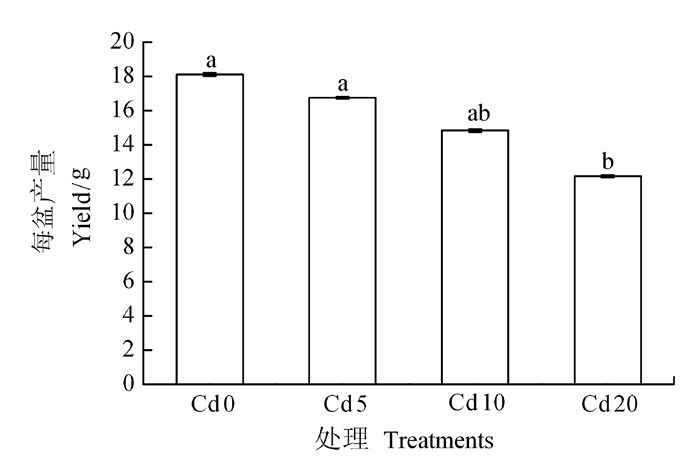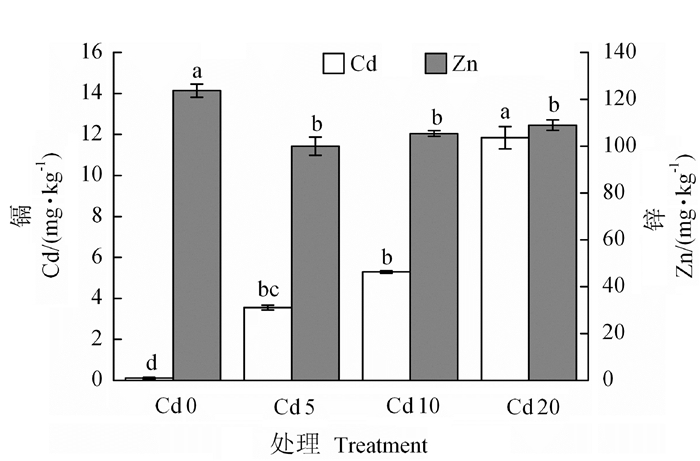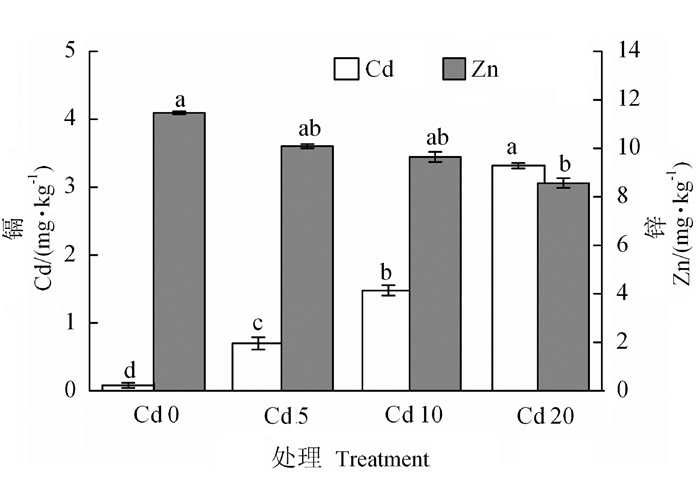Cd and Zn Uptakes and Quality of Sweet Potatoes under Cd-stress
-
摘要:目的 揭示土壤镉污染对甘薯品质及镉、锌吸收能力的影响。方法 通过盆栽试验,分析不同镉水平胁迫下甘薯产量、营养品质及镉、锌吸收的变化,同时采用迁移系数分析镉、锌在土壤-甘薯系统中的迁移转化特性。结果 随着土壤镉处理浓度的增加,甘薯块根产量呈下降趋势,最大程度可降低32.6%;块根果肉中蛋白质指标受影响程度较大,含量显著下降,最大程度可降低32.1%。镉胁迫会显著增加土壤和甘薯植株各部位的镉含量,但会抑制块根果肉对锌的吸收。种植甘薯可在一定程度上降低土壤中的镉含量,甘薯属于低镉吸收作物,当镉处理质量浓度不超过5 mg·kg-1时,块根果肉中镉含量基本低于国家安全限量标准(GB 2762-2017食品中污染物限量标准,Cd ≤ 0.1 mg·kg-1)。甘薯不同部位镉含量高低顺序为柴根>茎段>块根皮部>叶片>块根果肉,其中柴根和茎段部位对镉的迁移能力较大,镉主要富集在柴根部位。结论 在镉污染程度不高的土壤中,可以通过种植甘薯来富集镉,同时柴根部位对镉的截留可以减少镉通过食物链向人体迁移。Abstract:Objective Uptakes of Cd and Zn by sweet potato plants from Cd polluted soil was investigated.Method A pot experiment was conducted on the sweet potato to study the effects of Cd-stress on the yield, nutritional quality as well as the Cd and Zn uptakes of the plants. Migration and transformation of Cd and Zn from soil to plants were analyzed.Result The tuber yield of the plants decreased with increasing Cd in soil. It maximized at a reduction of 32.6%. The food quality of the tubers was greatly affected by the stress with a reduction on proteins as high as 32.1%. Cd-stress significantly increased the Cd concentrations in various parts of a plant land the soil, and inhibited the Zn absorption by the tubers. Sweet potato plants are not highly capable in absorbing Cd and can only reduce Cd in soil to a limited extent. Thus, so long as Cd in soil was less than 5 mg·kg-1, the tubers grown on it were basically safe for consumption as the Cd content in tuber would likely be below the national standard for safety (Cd ≤ 0.1 mg·kg-1). The Cd accumulations in parts of a plant were found to rank in the order of roots > stems > peel > leaves > flesh.The migration and transformation abilities of root and stem for Cd were higher, making Cd mainly accumulated in root.Conclusion Planting sweet potatoes could help mitigate the pollution effect only in soils not heavily contaminated with Cd. By eliminating the more Cd-concentrated roots on a tuber for food, risks on health could be largely avoided.
-
Keywords:
- sweet potato /
- Cd /
- Zn /
- nutritional quality /
- uptake ability
-
0. 引言
【研究意义】由于工业废弃物、生活污水等不合理排放,以及含重金属农业投入品的大量使用,致使农田土壤受到不同程度的重金属污染[1],其中镉是一种生物毒性很强且污染面极广的重金属。土壤中的镉易被农作物根系吸收并积累,影响农作物的正常生长发育,导致农作物品质下降,并且通过食物链传递,给人类健康带来不同程度的威胁[2-4]。已有研究表明,生物体内存在镉积累能力强的同时存在锌排斥作用显著的现象[5]。因此,研究农作物在镉胁迫下的生长情况以及镉、锌的吸收累积规律,对于镉污染土壤的合理利用和农作物安全生产具有重要的参考价值。【前人研究进展】关于镉胁迫对农作物品质方面的影响已有很多报道。过量镉胁迫会影响农作物对氮、磷、钾和一些微量元素的吸收、迁移与分配,如Xu等[6],Kováčik等[7]研究表明,镉胁迫会改变苜蓿、洋甘菊对土壤中营养元素的吸收。李君等[8]研究表明,镉胁迫会造成蓖麻中的钾和钙含量显著降低,低量镉胁迫促进蓖麻根系对磷的吸收,高量镉则抑制磷的迁移。不同农作物对土壤中镉的吸收及其在不同部位的积累有所差异。肖厚军等[9]采用盆栽试验方法,研究了不同镉水平胁迫下芹菜镉积累量的变化,结果表明芹菜镉吸收量随镉胁迫浓度增加而增加。曹亚茹等[10]对不同浓度镉胁迫的黄瓜镉积累量的研究表明,镉浓度在低于50 μmol·L-1时,黄瓜地上部镉富集量整体大于根部,而镉浓度在100、300 μmol·L-1时则呈相反趋势。【本研究切入点】甘薯在我国种植面积广泛,约占世界总面积的70%,不仅营养价值丰富,还是一种具有很高经济价值的粮食作物。甘薯的食用部分与土壤直接接触,受镉污染毒害的可能性较大。目前有关甘薯对镉的耐性以及富集方面的研究较少。刘昭兵等[11]研究表明,轻度镉污染土壤种植的甘薯其茎叶可能存在摄食健康风险,而块根基本无风险。胡玉龙等[12]研究了镉胁迫对甘薯苗生理生化指标的影响,结果表明镉胁迫会造成甘薯叶片光合作用减弱,加速甘薯叶的衰老。【拟解决的关键问题】本文以甘薯为试验材料,进行不同镉水平(0、5、10、20 mg·kg-1)的盆栽试验,对甘薯产量、营养指标及镉、锌含量进行测定,分析不同镉水平胁迫下甘薯产量和营养品质的变化,探索土壤镉胁迫对甘薯镉、锌吸收和积累的影响及甘薯体内镉-锌的关系,同时采用迁移系数分析镉、锌在土壤-甘薯系统中的迁移转化特性,以期为甘薯对镉污染土壤的耐性及其安全性评价研究奠定基础。
1. 材料与方法
1.1 供试材料
供试土壤来自福建闽西地区某水稻田,砂壤土,pH 5.20,有机质31.0 g·kg-1,全氮1.52 g·kg-1,全磷0.291 g·kg-1,全钾19.0 g·kg-1,全量镉0.169 mg·kg-1。供试薯苗来源于福建省农业科学院作物研究所基地。
1.2 试验设计
于2018年5月16日进行盆栽试验。每盆(高40 cm,直径35 cm)装供试土壤6 kg,设置4个不同镉水平处理:Cd 0(对照处理);Cd 5(5 mg·kg-1镉处理);Cd 10(10 mg·kg-1镉处理);Cd 20(20 mg·kg-1镉处理)。每个处理设置3个重复,将CdSO4(分析纯)与去离子水配成母液,逐级稀释成处理浓度后,与供试土壤反复混合均匀,室温下平衡30 d后测定各处理土壤中的镉质量比分别为0.156、5.070、10.100、20.200 mg·kg-1。于2018年6月17日选取长势基本一致的甘薯苗移栽至各处理的花盆中,每盆3穴,每穴1株,随机排列,种植后40 d左右完成松土1次。每桶施用0.5 g·kg-1的氮(尿素)、0.25 g·kg-1的磷(P2O5)和0.75 g·kg-1左右的钾(K2O),作为基肥一次性施入,其他管理措施按照甘薯常规栽培要求进行。
1.3 样品采集与处理
在成熟期采集甘薯植株样品,冲洗干净,分离植株的根部、茎段、叶片、块根皮部和块根果肉5个部位,称量鲜重后放入烘箱中105℃杀青30 min,在80℃烘干至恒重,冷却后分别称量各部位的干重,计算块根皮部和果肉部位干重之和为块根干重,然后将各部位样品磨碎,装自封袋保存备用。在采集植株样品的同时采集对应土壤样品,经实验室自然风干、磨碎,过100目尼龙筛保存备用。
1.4 营养品质测定
测定甘薯果肉的营养品质。甘薯淀粉含量按照国标GB 5009.9-2016中规定的方法测定;蔗糖和总糖含量按照国标GB 5009.7-2016和GB 5009.8-2016中规定的方法测定;粗纤维含量按照国标GB/T 6434-2006中规定的方法测定;粗脂肪含量按照国标GB 5009.6-2016中规定的方法测定;蛋白质含量按照国标GB 5009.5-2016中规定的方法测定。
1.5 样品消化和镉、锌含量测定
土壤样品采用HNO3-HF-HClO4三酸消解法消化。甘薯植株各部分样品采用HNO3-HClO4消解液消解。据土壤和甘薯样品消解液的镉、锌含量和仪器的最低检测限,用原子吸收光谱仪测定镉、锌含量,元素提取进行全程同步试剂空白控制,分析过程中每个样品均设平行双样。为保证样品消化和测定过程的准确性,以国家标准物质GSS-13(GBW07427)和GSB-25(GBW10047)作为质控样进行分析质量控制。分析土壤样品镉、锌的回收率分别为92.3%和89.6%,甘薯植株样品镉、锌的回收率分别为105%和92.7%,符合分析要求。
1.6 土壤-甘薯系统镉、锌的迁移
采用迁移系数(TF)来表示土壤-甘薯系统中镉、锌的迁移特征,它可以较好地反映土壤-甘薯系统中重金属元素迁移的难易程度[13]。具体计算方法:
TF=(Cc/Ce)×100%
式中,TF为重金属迁移系数;Ce为土壤、甘薯地下部(柴根)、甘薯地下部(块根皮部)、甘薯地下部(块根果肉)、甘薯地上部茎段和叶片中某个重金属元素的含量(mg·kg-1);Cc为迁入部位某个重金属元素的含量(mg·kg-1),土壤、柴根、块根皮部、块根果肉、茎段的迁入部位分别对应柴根、块根皮部、块根果肉、茎段和叶片。
1.7 数据分析与统计
利用Excel 2007、Origin 9.0软件进行数据分析,并制作相应图表;通过SPSS 18.0软件进行单因素方差分析Duncan检验。
2. 结果与分析
2.1 镉胁迫对甘薯产量及品质的影响
甘薯在不同镉胁迫水平下的块根产量和营养品质变化情况如图 1、2所示。
从图 1可以看到,对照处理的甘薯块根产量最高,每盆干重达18.1 g,但随着镉处理浓度的增加,甘薯块根产量逐渐降低。当镉为20 mg·kg-1时,每盆块根产量达到最低,为12.2 g,较对照处理降低32.6%,说明镉胁迫对甘薯块根产量的影响具有明显的浓度效应。方差分析结果显示,与Cd0处理相比,Cd5和Cd10处理下块根产量与其无明显差异,而Cd20处理下块根产量与其差异达显著水平(P<0.05)。
从图 2可以看出,随着镉处理水平的增加,甘薯块根果肉中淀粉、蔗糖和总糖含量呈先升后降的趋势,但与Cd0处理相比,没有引起显著性变化(P>0.05)。蛋白质含量随镉处理浓度增加而呈显著降低趋势(P<0.05)。当镉处理水平增加至20 mg·kg-1时,块根果肉中蛋白质含量由2.8 g·hg-1下降至1.9 g·hg-1,较对照处理降低32.1%,差异显著;粗纤维、粗脂肪含量不同处理间没有显著差异。说明同一镉水平胁迫下,甘薯中蛋白质含量受影响程度大于其他营养品质。
2.2 镉胁迫对甘薯种植后土壤中镉、锌含量的影响
甘薯种植后的土壤在不同镉胁迫水平下的镉、锌含量如图 3所示。
2.3 镉胁迫对甘薯块根果肉镉、锌含量的影响
甘薯在不同镉胁迫水平下的块根果肉中镉、锌含量如图 4所示。
从图 4可以看出,随着试验处理浓度的增加,甘薯块根果肉镉含量也随之升高,外加镉处理显著提高了块根果肉中的镉含量。在试验浓度范围内,低水平镉处理(5 mg·kg-1)下块根果肉镉含量为0.705 mg·kg-1,而高水平镉处理(20 mg·kg-1)下块根果肉镉含量达到了3.31 mg·kg-1,分别是对照处理下的8.5倍和40.0倍。为评价不同浓度处理下块根果肉镉含量超标情况,进一步将干样果肉镉含量折算成鲜样果肉镉含量(试验甘薯含水率85.5%)。经折算后,Cd0、Cd5、Cd10和Cd20处理下块根果肉鲜样中镉含量分别为0.012、0.101、0.214和0.481 mg·kg-1,与国家《食品中污染物限量标准》(GB 2762-2017),根茎类蔬菜Cd≤0.1 mg·kg-1相比,发现对照组和Cd5处理情况下,块根果肉中镉含量基本在安全范围内;在Cd10和Cd20处理下,块根果肉中镉含量均超标,分别是国家限量标准值的2.14倍和4.81倍。可见,在镉污染程度不高的土壤中可以通过种植甘薯来富集镉,以达到降低土壤中镉含量的目的。从不同试验处理下的块根果肉锌含量可以看出,与对照相比,Cd5、Cd10处理没有引起块根果肉锌含量的显著变化,而Cd20处理下块根果肉锌含量降低显著(P<0.05),镉处理质量比由5 mg·kg-1增加至20 mg·kg-1时,块根果肉中锌含量由10.1 mg·kg-1下降至8.56 mg·kg-1,高水平镉胁迫明显抑制了块根果肉对锌的吸收。
2.4 镉胁迫下甘薯植株各部位镉、锌含量变化
不同镉胁迫水平下甘薯植株吸收的镉、锌总量在各部位分配情况如表 1所示。从表 1可以看出,各试验处理下,甘薯植株不同部位镉含量基本呈柴根>茎段>块根皮部>叶片>块根果肉的趋势。随着试验镉处理水平的增加,甘薯植株各部位镉含量显著增加(P<0.05),表明外加镉处理提高了甘薯植株对镉的吸收。镉处理质量比由5 mg·kg-1增加至20 mg·kg-1时,柴根中镉含量分别是对照处理的37.6倍、85.6倍和206倍,茎段中镉含量分别是对照处理的20.1倍、45.0倍和74.5倍,块根皮部中镉含量分别是对照处理的6.50倍、26.9倍和59.3倍,叶片中镉含量分别是对照处理的3.91倍、10.1倍和19.9倍,块根果肉中镉含量分别是对照处理的8.60倍、18.1倍和40.4倍。而不同镉处理下甘薯植株对锌的吸收与镉规律并不一致,各试验处理下,甘薯植株不同部位吸收的锌基本呈叶片>柴根>茎段>块根皮部>块根果肉的趋势。随着镉处理水平的增加,柴根和块根果肉部位的锌含量呈下降趋势,茎段部位表现出完全相反的结果,呈显著性增加趋势(P<0.05),叶片和块根皮部的锌含量无显著性变化。
表 1 镉胁迫下甘薯各部位镉、锌的含量变化Table 1. Contents of Cd and Zn in parts of tuber of sweet potato plants under Cd-stress[单位/(mg·kg-1)] 元素
Elements植株各部位
Parts of plant处理
TreatmentsCd 0 Cd 5 Cd 10 Cd 20 镉Cd 柴根Root 0.61±0.011d 22.80±0.306c 51.90±0.360b 125.00±0.909a 块根皮部Root peel 0.23±0.016d 1.47±0.071c 6.07±0.036b 13.40±0.106a 块根果肉Root pulp 0.08±0.036d 0.70±0.089c 1.48±0.078b 3.31±0.044a 茎段Stem 0.28±0.013d 5.58±0.102c 12.50±0.051b 20.70±0.089a 叶片Leaf 0.15±0.055d 0.60±0.068c 1.55±0.112b 3.07±0.133a 锌Zn 柴根Root 33.40±0.192a 29.10±0.203ab 27.00±0.335bc 25.30±0.213c 块根皮部Root peel 17.10±0.133a 17.70±0.331a 17.40±0.051a 17.70±0.639a 块根果肉Root pulp 11.50±0.058a 10.10±0.088ab 9.64±0.208ab 8.56±0.197b 茎段Stem 17.60±0.112d 19.70±0.336c 22.20±0.057b 26.50±0.133a 叶片Leaf 51.50±0.103a 50.80±0.180a 51.70±0.403a 52.30±0.354a 注:同行数据后无相同小写字母者表示处理间差异显著(P < 0.05),表 2同。
Note: Data with different lowercase letters on a same row indicate significant differences at P < 0.05. Same for Table 2.表 2 镉胁迫下甘薯镉、锌的迁移系数Table 2. Translocation factors of Cd and Zn on sweet potato plants under Cd-stress元素
Elements迁入部位
Immigration part迁移系数Transfer factors Cd 0 Cd 5 Cd 10 Cd 20 镉Cd 柴根Root 5.06±0.113 6.43±0.107 9.81±0.88 10.60±0.776 块根皮部Root peel 0.37±0.005 0.06±0.004 0.12±0.012 0.11±0.001 块根果肉Root pulp 0.36±0.030 0.48±0.004 0.24±0.001 0.25±0.004 茎段Stem 3.39±0.096 7.91±0.179 8.45±0.275 6.25±0.316 叶片Leaf 0.55±0.031 0.11±0.024 0.12±0.020 0.15±0.014 锌Zn 柴根Root 0.27±0.053 0.29±0.014 0.26±0.008 0.23±0.035 块根皮部Root peel 0.51±0.014 0.61±0.003 0.64±0.014 0.70±0.001 块根果肉Root pulp 0.67±0.055 0.57±0.010 0.55±0.014 0.48±0.030 茎段Stem 1.53±0.195 1.95±0.044 2.30±0.128 3.10±0.164 叶片Leaf 2.93±0.106 2.58±0.077 2.33±0.012 1.97±0.042 2.5 镉胁迫下土壤-甘薯系统镉、锌的迁移
采用迁移系数(TF)反映重金属在土壤-甘薯系统中的运输和分配情况,不同镉胁迫水平下甘薯对镉、锌的迁移能力如表 2所示。从表 2可以看出,各试验处理下,甘薯植株柴根和茎段对镉的迁移系数均大于1,说明甘薯对镉从土壤向柴根、果肉向茎段的迁移能力较强。块根皮部和块根果肉对镉的迁移系数均小于1,说明甘薯对镉从柴根向皮部、皮部向果肉的迁移能力较弱。随着镉处理水平的升高,甘薯柴根部位对镉的迁移系数呈增加趋势,说明镉胁迫促进了镉从土壤向柴根的迁移。对锌而言,各试验处理下,甘薯植株茎段和叶片对锌的迁移系数均大于1,说明甘薯对锌从果肉向茎段、茎段向叶片的迁移能力较强。柴根、块根皮部和块根果肉对锌的迁移系数均小于1,说明甘薯对锌从土壤向柴根、柴根向皮部、皮部向果肉的迁移能力均较弱。随着镉处理水平的升高,甘薯茎段部位对锌的迁移系数呈增加趋势,叶片部位对锌的迁移系数呈降低趋势。
3. 讨论
研究表明,镉胁迫不仅影响作物的正常生长发育,同时影响作物的品质特性[2, 14]。本研究结果显示,甘薯块根产量随镉处理水平的增加而明显降低,其原因可能是镉胁迫抑制了甘薯根系的生长,导致光合作用减弱,进而影响甘薯的生长发育,从而降低甘薯块根的产量[15]。值得一提的是,当镉胁迫质量比为20 mg·kg-1时,甘薯仍保持一定的生长状态,说明甘薯对镉具有较高的耐受性。营养品质分析结果表明,镉胁迫对甘薯中蛋白质含量的影响程度较大,在Cd20处理下,蛋白质含量较对照处理下降了32.1%,其原因可能在于镉胁迫导致土壤中含氮量降低,硝酸还原酶活性减弱,从而抑制了蛋白质的合成[16]。
不同作物对镉的吸收存在偏好性差异,绝大多数作物对镉的吸收随土壤中镉浓度的升高而增加[17]。本研究结果也表明,镉胁迫会增加甘薯对土壤中镉的吸收能力。刘昭兵等[11]的研究表明,甘薯的地上部茎叶和地下部块根间的镉含量差异明显,茎叶中镉的累积主要来源于根系对土壤中镉的吸收迁移。本研究中,镉胁迫下甘薯植株不同部位镉含量均呈柴根>茎段>块根皮部>叶片>块根果肉的趋势。通过比较甘薯不同部位的迁移系数可知,甘薯中镉从土壤向柴根、果肉向茎段的迁移能力较强,这可能是导致柴根和茎段部位镉含量较高的主要原因。在本试验镉水平范围内,柴根部位对镉的迁移能力随土壤中镉胁迫水平增加而增大,而镉从柴根向皮部、皮部向果肉的迁移能力较弱。由此可见,甘薯植株中的镉主要富集在柴根部位,柴根部位对镉的截留可以减少镉通过食物链向人体迁移。另外,通过与国家《食品中污染物限量标准》(GB 2762-2017,根茎类蔬菜Cd≤0.1 mg·kg-1)相比,发现在镉处理质量比不超过5 mg·kg-1时,块根果肉中镉含量基本在安全范围内,说明甘薯属于低镉吸收作物。张超凡等[18]研究表明,甘薯多数品种为低镉吸收品种,与高镉吸收的马铃薯在同一块耕地上进行轮作耕种,可以起到很好的互补作用,改善土壤环境,降低土壤镉含量。由此可见,在镉污染程度不高的土壤中可以通过种植甘薯来富集镉,以达到降低土壤中镉含量的目的。
作物体内镉与锌存在着复杂的交互影响关系[19]。该研究结果显示,甘薯植株各部位镉含量随镉处理浓度增加而增加,而高浓度的镉胁迫会明显降低甘薯块根果肉中锌的含量,说明甘薯体内镉与锌可能存在拮抗作用,类似的规律也存在于水稻等作物中。史静等[20]研究表明,水稻在吸收镉的同时会排斥对锌的吸收,高镉暴露会导致锌存在相对缺乏的食物安全风险。这一现象可能是由不同镉胁迫下作物中镉/锌比的差异导致,有研究认为作物中的镉/锌比是影响镉潜在生物毒性的重要因素,高镉/锌比可提高镉进入生物消化道后的生理毒害作用[21]。然而另一些研究表明,作物体内镉与锌是一种协同作用[22],施锌可以促进作物对镉的吸收积累。可见,镉-锌交互作用对作物的影响较为复杂,其机理还有待进一步探究。
4. 结论
(1) 不同程度镉胁迫对甘薯块根产量和品质均有影响。随着土壤镉处理水平增加,块根产量呈下降趋势,最大程度可降低32.6%;块根果肉中蛋白质指标受影响程度较大,含量明显下降,最大程度可降低32.1%。
(2) 镉胁迫会显著增加土壤和甘薯植株各部位的镉含量,也会抑制块根果肉对锌的吸收;种植甘薯可在一定程度上降低土壤中的镉含量,甘薯属于低镉吸收作物,当镉处理浓度不超过5 mg·kg-1时,块根果肉中镉含量低于国家安全限量标准(GB 2762-2017食品中污染物限量标准,Cd≤0.1 mg·kg-1)。
(3) 甘薯不同部位对镉的吸收量呈现柴根>茎段>块根皮部>叶片>块根果肉的趋势,其中柴根和茎段部位对镉的迁移能力较大,镉主要富集在柴根部位,因此柴根部位对镉的截留可以减少镉通过食物链向人体迁移。
-
表 1 镉胁迫下甘薯各部位镉、锌的含量变化
Table 1 Contents of Cd and Zn in parts of tuber of sweet potato plants under Cd-stress
[单位/(mg·kg-1)] 元素
Elements植株各部位
Parts of plant处理
TreatmentsCd 0 Cd 5 Cd 10 Cd 20 镉Cd 柴根Root 0.61±0.011d 22.80±0.306c 51.90±0.360b 125.00±0.909a 块根皮部Root peel 0.23±0.016d 1.47±0.071c 6.07±0.036b 13.40±0.106a 块根果肉Root pulp 0.08±0.036d 0.70±0.089c 1.48±0.078b 3.31±0.044a 茎段Stem 0.28±0.013d 5.58±0.102c 12.50±0.051b 20.70±0.089a 叶片Leaf 0.15±0.055d 0.60±0.068c 1.55±0.112b 3.07±0.133a 锌Zn 柴根Root 33.40±0.192a 29.10±0.203ab 27.00±0.335bc 25.30±0.213c 块根皮部Root peel 17.10±0.133a 17.70±0.331a 17.40±0.051a 17.70±0.639a 块根果肉Root pulp 11.50±0.058a 10.10±0.088ab 9.64±0.208ab 8.56±0.197b 茎段Stem 17.60±0.112d 19.70±0.336c 22.20±0.057b 26.50±0.133a 叶片Leaf 51.50±0.103a 50.80±0.180a 51.70±0.403a 52.30±0.354a 注:同行数据后无相同小写字母者表示处理间差异显著(P < 0.05),表 2同。
Note: Data with different lowercase letters on a same row indicate significant differences at P < 0.05. Same for Table 2.表 2 镉胁迫下甘薯镉、锌的迁移系数
Table 2 Translocation factors of Cd and Zn on sweet potato plants under Cd-stress
元素
Elements迁入部位
Immigration part迁移系数Transfer factors Cd 0 Cd 5 Cd 10 Cd 20 镉Cd 柴根Root 5.06±0.113 6.43±0.107 9.81±0.88 10.60±0.776 块根皮部Root peel 0.37±0.005 0.06±0.004 0.12±0.012 0.11±0.001 块根果肉Root pulp 0.36±0.030 0.48±0.004 0.24±0.001 0.25±0.004 茎段Stem 3.39±0.096 7.91±0.179 8.45±0.275 6.25±0.316 叶片Leaf 0.55±0.031 0.11±0.024 0.12±0.020 0.15±0.014 锌Zn 柴根Root 0.27±0.053 0.29±0.014 0.26±0.008 0.23±0.035 块根皮部Root peel 0.51±0.014 0.61±0.003 0.64±0.014 0.70±0.001 块根果肉Root pulp 0.67±0.055 0.57±0.010 0.55±0.014 0.48±0.030 茎段Stem 1.53±0.195 1.95±0.044 2.30±0.128 3.10±0.164 叶片Leaf 2.93±0.106 2.58±0.077 2.33±0.012 1.97±0.042 -
[1] 李田玲.重金属污染对蔬菜基地的影响及防治对策[J].甘肃科技, 2012, 28(1): 51-53. DOI: 10.3969/j.issn.1000-0952.2012.01.019 LI T L. Effects of heavy metal pollution on vegetable bases and its control measures[J]. Gansu Science and Technology, 2012, 28(1): 51-53.(in Chinese) DOI: 10.3969/j.issn.1000-0952.2012.01.019
[2] 李兆君, 马国瑞, 徐建民, 等.植物适应重金属Cd胁迫的生理及分子生物学机理[J].土壤通报, 2004, 35(2): 234-238. DOI: 10.3321/j.issn:0564-3945.2004.02.031 LI Z J, MA G R, XU J M, et al. Physiological and biological mechanism of plant for adapting the stress by cadmium[J]. Chinese Journal of Soil Science, 2004, 35(2): 234-238.(in Chinese) DOI: 10.3321/j.issn:0564-3945.2004.02.031
[3] SATO A, TAKEDA H, OYANAGI W, et al. Reduction of cadmium uptake in spinach (Spinacia oleracea L.) by soil amendment with animal waste compost[J]. Joumal of Hazardous Materials, 2010, 181(1/3): 298-304. http://cn.bing.com/academic/profile?id=9abcbf55aa442f9181782d7178e55140&encoded=0&v=paper_preview&mkt=zh-cn
[4] 于方明, 刘可慧, 刘华, 等.镉污染对水稻不同生育期抗氧化系统的影响[J].生态环境学报, 2012, 21(1): 88-93. DOI: 10.3969/j.issn.1674-5906.2012.01.017 YU F M, LIU K H, LIU H, et al.Antioxidative responses to cadmium stress in the leaves of Oryza saliva L.in different growth period[J]. Ecology and Environmental Sciences, 2012, 21(1): 88-93.(in Chinese) DOI: 10.3969/j.issn.1674-5906.2012.01.017
[5] 龚伟群, 潘根兴.中国水稻生产中Cd吸收及其健康风险的有关问题[J].科技导报, 2006, 24(5): 43-47. DOI: 10.3321/j.issn:1000-7857.2006.05.011 GONG W Q, PAN G X. Issues of grain Cd uptake and the potential health risk of rice production sector of China[J]. Science and Technology Herald, 2006, 24(5): 43-47.(in Chinese) DOI: 10.3321/j.issn:1000-7857.2006.05.011
[6] XU J, WANG W, YIN H, et al. Exogenous nitric oxide improves antioxidative capacity and reduces auxin degradation in roots of Medicago truncatula seedlings under cadmium stress[J]. Plant and Soil, 2010, 326(1): 321-330. http://www.wanfangdata.com.cn/details/detail.do?_type=perio&id=24e586c55d9b804412941730a53c912b
[7] KOVÁČIK J, BABULA P, KLEJDUS B, et al. Unexpected behavior of some nitric oxide modulators under cadmium excess in plant tissue[J]. PLoS One, 2014, 9(3): e91685. DOI: 10.1371/journal.pone.0091685
[8] 李君, 葛跃, 王明新, 等.镉对蓖麻耐性生理及营养元素吸收迁移的影响[J].环境科学学报, 2016, 36(8): 3081-3087. http://www.cnki.com.cn/Article/CJFDTotal-HJXX201608046.htm LI J, GE Y, WANG M X, et al.Effects of Cd on tolerance physiology, nutrientsuptake and translocationinRicinus communis L. Acta Scientiae Circumstantiae, 2016, 36(8): 3081-3087.(in Chinese) http://www.cnki.com.cn/Article/CJFDTotal-HJXX201608046.htm
[9] 肖厚军, 芶久兰, 何佳芳, 等.镉胁迫下芹菜产量和氮, 磷, 钾吸收及镉积累量的变化[J].环境科技, 2014, 27(4): 10-13. DOI: 10.3969/j.issn.1674-4829.2014.04.003 XIAO H J, GOU J L, HE J F, et al.Effect of cadmium stress on yield, nitrogen, phosphorus, potassium and cadmium uptake of apium graveolens[J]. Environmental Science and Technology, 2014, 27(4): 10-13.(in Chinese) DOI: 10.3969/j.issn.1674-4829.2014.04.003
[10] 曹亚茹, 孙凯宁, 王克安, 等.镉(Cd)胁迫对5种类型黄瓜幼苗生长, 抗氧化酶活性及镉积累量的影响[J].山东农业科学, 2017, 49(9): 107-113. http://www.wanfangdata.com.cn/details/detail.do?_type=perio&id=shandnykx201709020 CAO Y R, SUN K N, WANG K A, et al.Effects of Cd2+ stress on growth, antioxidant enzvme actiVity and cadmium enrichment of cucumber seedings[J]. Shandong Agricultural Sciences, 2017, 49(9): 107-113.(in Chinese) http://www.wanfangdata.com.cn/details/detail.do?_type=perio&id=shandnykx201709020
[11] 刘昭兵, 纪雄辉, 田发祥, 等.不同基因型甘薯(Ipomoea batatas Lam.)吸收累积Cd的特征差异性研究[J].农业环境科学学报, 2010, 29(9): 1653-1658. http://d.old.wanfangdata.com.cn/Periodical/nyhjbh201009004 LIU Z B, JI X H, TIAN F X, et al.Absorption and accumulation of Cd in different sweet potato(Ipomoea batatas Lam.)genotypes[J]. Journal of Agro-Environment Science, 2010, 29(9): 1653-1658.(in Chinese) http://d.old.wanfangdata.com.cn/Periodical/nyhjbh201009004
[12] 胡玉龙, 李雪华, 赵苹艺, 等.镉胁迫对甘薯苗生理生化指标的影响[J].湖北农业科学, 2015, 54(4): 858-861. http://d.old.wanfangdata.com.cn/Periodical/hbnykx201504021 HU Y L, LI X H, ZHAO P Y, et al.Effects of cadmium stress on physiologic and biochemical characteristics of sweet potato[J]. Hubei Agricultural Sciences, 2015, 54(4): 858-861.(in Chinese) http://d.old.wanfangdata.com.cn/Periodical/hbnykx201504021
[13] GUPTA S, NAYEK S, SAHA R N, et al. Assessment of heavy metal accumulation in macrophyte, agricultural soil, and crop plants adjacent to discharge zone of sponge iron factory[J]. Environmental Geology, 2008, 55(4): 731-739. DOI: 10.1007/s00254-007-1025-y
[14] 刘侯俊, 梁吉哲, 韩晓日, 等.东北地区不同水稻品种对Cd的累积特性研究[J].农业环境科学学报, 2011, 30(2): 220-227. http://d.old.wanfangdata.com.cn/Periodical/nyhjbh201102003 LIU H J, LIANG J Z, HAN X R, et al.Accumulation and distribution of cadmium in different rice cultivars of Northeastern China[J]. Journal of Agro-Environment Science, 2011, 30(2): 220-227.(in Chinese) http://d.old.wanfangdata.com.cn/Periodical/nyhjbh201102003
[15] 王英, 李正文, 贺紫荆.不同水稻品种积累镉的差异及其动态变化[J].广西农业生物科学, 2007, 26(B06): 82-85. http://d.old.wanfangdata.com.cn/Periodical/gxnyswkx2007z1019 WANG Y, LI Z W, HE Z J. Difference and dynamics of Cd up takeinfourrice cultivars[J]. Guangxi Agricultural Biology Science, 2007, 26(B06): 82-85.(in Chinese) http://d.old.wanfangdata.com.cn/Periodical/gxnyswkx2007z1019
[16] 张辉, 张永春.肥料对甘薯营养品质影响的研究进展[J].江苏农业科学, 2017, 45(17): 1-5. http://d.old.wanfangdata.com.cn/Periodical/jsnykx201717001 ZHANG H, ZHANG Y C. Research progress on effect of fertilizer on nutritional quality of sweet potato[J]. Jiangsu Agricultural Science, 2017, 45(17): 1-5.(in Chinese) http://d.old.wanfangdata.com.cn/Periodical/jsnykx201717001
[17] 朱勇, 叶宇飞, 江潇潇, 等.铅镉污染土壤上蔬菜种类的选择[J].浙江农业科学, 2010(2): 383-385. DOI: 10.3969/j.issn.0528-9017.2010.02.058 ZHU Y, YE Y F, JIANG X X, et al.Selection of vegetable species in lead and cadmium contaminated soils[J]. Zhejiang Agricultural Science, 2010(2): 383-385.(in Chinese) DOI: 10.3969/j.issn.0528-9017.2010.02.058
[18] 张超凡, 张道微, 黄艳岚, 等.甘薯与马铃薯在土壤镉污染治理中的应用研究进展[J].湖南农业科学, 2015 (9): 87-90. http://d.old.wanfangdata.com.cn/Periodical/hunannykx201509027 ZHANG C F, ZHANG D W, HUANG Y L, et al.Application research progress of sweet potato and potato in soil Cd pollution control[J]. Hunan Agricultural Science, 2015 (9): 87-90.(in Chinese) http://d.old.wanfangdata.com.cn/Periodical/hunannykx201509027
[19] 艾伦弘, 汪模辉, 李鉴伦, 等.镉及镉锌交互作用的植物效应[J].广东微量元素科学, 2005, 12(12): 6-11. DOI: 10.3969/j.issn.1006-446X.2005.12.002 AI L H, WANG M H, LI J L, et al.Effects of single Cd and interaction between Cd andZn on plant growth[J]. Guangdong Trace Elements Science, 2005, 12(12): 6-11.(in Chinese) DOI: 10.3969/j.issn.1006-446X.2005.12.002
[20] 史静, 潘根兴, 张乃明.镉胁迫对不同杂交水稻品种Cd, Zn吸收与积累的影响[J].环境科学学报, 2013, 33(10): 2904. http://www.cnki.com.cn/Article/CJFDTotal-HJXX201310035.htm SHI J, PAN G X, ZHANG N M. Effects of cadmium stress on Cd and Zn uptake and accumulation of different cultivarsof hybrid rice[J]. Acta Scientiae Circumstantiae, 2013, 33(10): 2904.(in Chinese) http://www.cnki.com.cn/Article/CJFDTotal-HJXX201310035.htm
[21] CHANEY R L, REEVES P G, RYAN J A, et al. An improved understanding of soil Cd risk to humans and low cost methods to phytoextract Cd from contaminated soils to prevent soil Cd risks[J]. Biometals, 2004, 17(5): 549-553. DOI: 10.1023/B:BIOM.0000045737.85738.cf
[22] KÖLELI N, EKER S, CAKMAK L. Effect of zinc fertilization on cadmium toxicity in durum and bread wheat grown in zinc-deficient soil[J]. Environmental Pollution, 2004, 131(3): 453-459. DOI: 10.1016/j.envpol.2004.02.012
-
期刊类型引用(6)
1. 彭杨,贺峦,高学鹏,黄向荣. 生物炭负载纳米氧化锌对复合污染油茶生理生化、元素吸收及土壤性质的影响. 江苏农业科学. 2024(19): 180-186 .  百度学术
百度学术
2. 陈涵,胡慧云,程建峰,黄英金,毛晓嵘,徐小明,曾研华. 不同基因型甘薯块根自然富集元素能力的差异性. 河南农业科学. 2023(07): 24-39 .  百度学术
百度学术
3. 张瑞瑞,刘鸿雁,刘克,周显勇,王雪雯,罗凯. 不同土壤类型马铃薯对镉的富集转运差异研究. 中国马铃薯. 2021(02): 156-163 .  百度学术
百度学术
4. 熊敏先,吴迪,许向宁,郑明阳,邢涛. 土壤重金属镉对高等植物的毒性效应研究进展. 生态毒理学报. 2021(06): 133-149 .  百度学术
百度学术
5. 靳艳玲,丁凡,方扬,易卓林,杜安平,赵海. 甘薯对土壤中镉的吸收特征研究. 食品安全质量检测学报. 2020(24): 9194-9200 .  百度学术
百度学术
6. 张道微,董芳,张亚,黄艳岚,张超凡. 镉污染土壤中甘薯镉元素的时空积累规律. 华北农学报. 2020(S1): 289-298 .  百度学术
百度学术
其他类型引用(7)





 下载:
下载:



